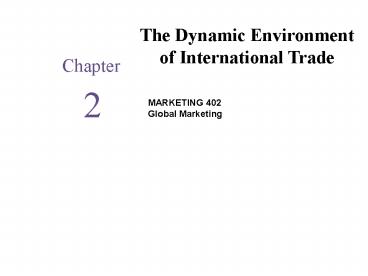The Dynamic Environment of International Trade - PowerPoint PPT Presentation
1 / 24
Title:
The Dynamic Environment of International Trade
Description:
Business concepts important in understanding the relationship between a ... Arbitrate Trade Disputes. International Monetary Fund (IMF) Established in 1944 ... – PowerPoint PPT presentation
Number of Views:480
Avg rating:3.0/5.0
Title: The Dynamic Environment of International Trade
1
The Dynamic Environment of International Trade
Chapter
2
MARKETING 402 Global Marketing
2
Todays Discussion
A brief summary of U.S.s past and present role
in global trade Business concepts important in
understanding the relationship between a
countrys economic policy and international
trade The nature and scope of Keiretsus
3
U.S. Role in Global Trade Past Present
1900-1940 Major World-Wide Economic
Depression 1945- Capitalism-Socialism Communism
Struggles
- Marshall Plan
- Agency for International Development (AID)
- Dissolution of Colonial Power
- International Trading Cooperation
- GATT (1946) Smoot-Hawley Law (1930)
- World Trade Organization (1994)
4
The 20th Century
1945-
- U.S. Multinational Corporation World Dominance
Challenged - Limitations on U.S. Direct Investments
- Competition for Export Markets
- U.S. Balance of Merchandise Trade Shifts
5
The 21st Century
1990s-Present
- Large Mature International Markets are Still
Important - More Intense Competition
- Continued Drive for Efficiency, Productivity, and
Global Market Share
6
Important Concepts
- Balance of Payments
- Omnibus Trade of Competitiveness Act
- Protectionism
- Easing Trade Restrictions
7
Balance of Payments
A countrys international transactions are
recorded in a system of accounts called its
balance of payments.
Definition the difference between receipts from
foreign countries on one side and payments to
them on the other during a given period of time.
8
Balance of Payments (cont)
2-8
- Balance of Trade
- Vs Balance of Payments
- Impact on Balance of Payments
9
The Omnibus Trade Competitiveness Act (1988)
- Objective Lower the U.S. trade deficit
- Assist U.S. Business Competitiveness-
- Market Access
- Export Expansion
- Import Relief
10
Protectionism
2-12
- Protecting a countrys markets from foreign
competitors - Legal barriers
- Exchange barriers
- Psychological barriers
11
Why do Countries Favor Protectionism?
- national defense
- infant industries
- industrialization of low-wage countries
- home market
- maintenance of the standard of living
- capital accumulation
- keep money at home
- conserve natural resources
- employment
- increase business size
- retaliation bargaining
12
Tariffs
Tariffs are a tax on goods entering a
country. They may be imposed to discourage
imports or generate revenue.
13
The Effects of Tariffs
Increase Inflationary pressures. Special
interests privileges. Government
control and political considerations in
economic matters. The number of tariffs
they beget via reciprocity. Weaken
Balance-of-payments positions.
Supply-and-demand patterns.
International understanding (they can start
trade wars). Restrict Manufacturer
supply sources. Choices available to
consumers Competition.
2-10
Irwin/McGraw-Hill
14
Types of Non-tariff Barriers
Specific Limitations on Trade ? Quotas ?
Import Licensing requirements ? Proportion
restrictions of foreign to domestic goods
(local content requirements) ? Minimum import
price limits ? Embargoes Customs and
Administrative Entry Procedures ? Valuation
systems ? Antidumping practices ? Tariff
classifications ? Documentation
requirements ? Fees
Irwin/McGraw-Hill
15
Types of Non-tariff Barriers
Standards ? Standard disparities ?
Intergovernmental acceptances of testing methods
and standards ? Packaging, labeling,
marking and safety standards
Government Participation in Trade ? Government
procurement policies ? Export subsidies ?
Countervailing duties ? Domestic assistance
programs
Irwin/McGraw-Hill
16
Types of Non-tariff Barriers
Charges on imports ? Prior import deposit
subsidies ? Administrative fees ? Special
supplementary duties ? Import credit
discriminations ? Variable levies ? Border
taxes Others ? Voluntary export
restraints ? Orderly marketing agreements
SOURCE A.D. Cao, Nontariff Barriers to U.S.
Manufactured Exports, The Columbia Journal of
World Business, Summer 1980, P.94.
Irwin/McGraw-Hill
17
Monetary Barriers
Blocked Currency
Differential Exchange Rate
Government Approval to Secure Foreign Exchange
Exchange Permit
Irwin/McGraw-Hill
18
General Agreement on Tariff Trade (GATT)
- Agreements Elements
- Nondiscriminatory Trade
- Domestic Trade Protected by Tariffs, not import
quotas - Solve Trade Problems Through Consultation
19
GATT The Uruguay Round (1986-1994)
- Market Access to Vital Industries
- International Trade Services Issues
- Investment Barriers Addressed
- Intellectual Property Rights
20
World Trade Organization
- An Institution of GATT Members
- Set Trade Rules
- Arbitrate Trade Disputes
21
International Monetary Fund (IMF)
- Established in 1944
- Fund European/Japanese Economic Recovery
- Stabilize Foreign Exchange Rates
- Establish Freely Convertible Currencies
22
Keiretsu
2-26
Keiretsu Collections of major companies
spanning several industries and held together by
- Cross-Shareholding
- Business Relationships
- Preferential Treatment
- Cooperative Relationship with Domestic
Competitors - Interlocking Directorates
- Social Historical Links
23
Kieretsu
2-29
- Benefits
- Membership stability
- encourage investment in new technology share
these costs - Freer flow of information
- inter-company coordination
- planning, production scheduling
- competitive co-operation on new technology
24
Kieretsu
- Costs
- unfair competition claims
- economic power
- U.S. imports restricted
- higher prices, few choices































